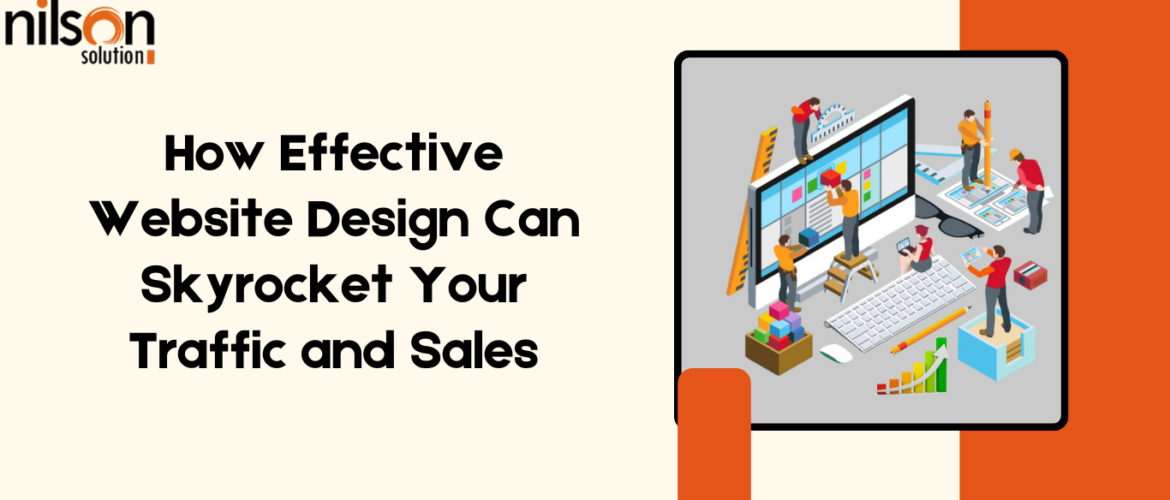Ever wondered why some websites can attract visitors and turn them into regular customers so smoothly, while others really struggle to gain even a semblance of traction? It often lies in the design of the website.
It’s right; in this modern digital world, where people’s first impressions are shaped within a few seconds, design plays an integral role in driving traffic to your website and further conversions. Web development deals with the creation of dynamic and interactive websites.
Website design not only has to deal with the looks of your site but also entails layout, structure, usability, and responsiveness—things all related to the perception and navigation that visitors have while getting through your brand and site. Website redesign can improve the site’s functionality and user engagement. Let’s explore how an effective website design transforms your online presence, boosting traffic and sales.
Pros of User Experience in Website Designing
A website that enables easy navigation, visual appeal, and responsiveness to the needs of users creates a positive experience, keeping the visitors engaged with it. If users are able to find the required information quickly and easily, it would mean the person will remain there for a longer time, view more pages, and buy. Investment in website redesign modernizes the online presence for a business.
One important element in user experience design is intuitive navigation. A clear and logical navigation through a website helps users collect all the information they need faster, reducing frustration and bounce rate. A solid foundation in web development is essential for the creation of successful web applications.
Aesthetic Attraction and Its Impact on Traffic and Revenue
Digital marketing leverages online channels to reach targeted audiences effectively. The visual appeal of a website is what often has the initial attention of a visitor. In addition, a modern-looking website that is clean and professionally designed can create a strong first impression, making visitors more likely to stay on the site and explore. Companies use digital marketing to enhance their online presence and boost sales.
Here are some key visual elements that can enhance your website’s appeal:
Color Palette: The colors used for your website are to work with your brand and elicit the proper emotions. For instance, blue is often associated with trust, while red has the power to create feelings of urgency. An integrated color scheme is a beautiful way to design a beautiful, very visual experience that resonates with your target audience. Social media marketing allows businesses to connect with customers on various platforms.
Typography The fonts you choose have huge implications for both aesthetics and readability. A thoughtfully chosen, very legible, clean font whose use is carefully maintained assures the user experience remains positive and that your brand is represented professionally.
Enhance the interactivity of your website with images and multimedia elements that should be relevant to the content and help display a fit and proper way to get your message across. A robust social media marketing strategy can increase brand loyalty and customer engagement.
Whitespace is more prosaically known as negative space—the empty areas of your page that lie in between elements. Proper use of whitespace makes your content readable and adds a level of sophistication to your design so that your website won’t look cluttered.
Key Design Elements that Boost Conversion Rates
Successful website design encompasses more than merely drawing in visitors; it involves transforming these visitors into customers. Numerous design components can significantly influence conversion rates, converting casual browsers into committed customers.
Explicit Call-to-Action (CTA)
Buttons on your website identified as which should attract notice, looking contrastive to others, and thus should be very accessible. Effective lead generation strategies are vital for building a strong sales pipeline.
Trust Signals:
Adding trust signals to your site becomes more of an issue with visitors on your site, whereby e-commerce sites have to give spiders confidence in themselves. Lead generation focuses on attracting and capturing potential customer interest.
Simplify Checkout Process:
Of all e-commerce websites, the checkout process needs to be the simplest. If the checkout becomes too long or complicated, it is a one-way ticket to cart abandonment; hence, the steps for completing a purchase should be kept to a minimum.
Landing Page Optimization:
The one factor that cannot be ignored about landing pages is that they have to be optimized for your audience. These would have a strong, clear headline, focused, and compelling copy, and a purpose-aligned CTA.
The SEO Advantage of Effective Website Design.
SEO always goes hand in hand with web design. In a carefully built website, usability won’t go against the algorithms of search engines, and one may see improvements in SERP positions. Lead conversion is the process of turning prospects into paying customers. Enhancing lead conversion rates can significantly boost business growth and profitability.
Effective web design in the digital landscape is a potential tool to create a drastic improvement in both traffic and sales. Keeping in view the user experience, visual appeal, and other critical design elements driving conversions, you can build an attracting website that magnetically brings visitors and turns them into customers. Additionally, by implementing the best practices of SEO into your design, it will increase the visibility of the site to several more.

